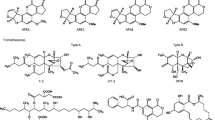Abstract
Based on several alerts from European countries over the last years concerning spices, we have been encouraged to establish an accurate method for the determination of dyes, aflatoxins and pesticides in various types of spices using reversed-phase (RP) liquid chromatography–tandem mass spectrometry interfaced with electrospray (LC–ESI–MS/MS). A simple sample treatment procedure entailing the use of an extraction step with acetonitrile without further cleanup has been developed. A C18 column with an aqueous ammonium formate/methanol mixture as the mobile phase was used, and gradient elution was performed. Mass spectral acquisition was done in positive ion mode by applying multiple reaction monitoring of at least two fragmentation transitions per compound to provide a high degree of selectivity. The method was in-house validated in terms of linearity, sensitivity, repeatability, recovery and selectivity on six kinds of spices. Satisfactory results in the majority of the cases were obtained for all analytes and matrices, with practical limits of quantitation acceptable for routine monitoring purposes. Extraction recoveries for most of the compounds ranged from 60% to 140% at spiking levels of 0.05 and 0.5 mg kg−1. The applicability of the method for the simultaneous determination of dyes, aflatoxins and pesticides in several types of spices was demonstrated, and the method successfully applied to a limited number of products from the local market.




Similar content being viewed by others
References
European Union (2009) RASFF portal. https://webgate.ec.europa.eu/rasff-window/portal/. Accessed 24 Aug 2009
Abou-Arab AAK, Abou Donia M (2001) Food Chem 72(4):439–445
Vidott ECI, Cancino JC, Oliveira CC, Rollemberg ME (2005) Anal Sci 21(2):149–153
Reisch MS (1988) Chem Eng News 66:7–14
Raffi F, Hall JD, Cerniglia CE (1997) Food Chem Toxicol 35(9):897–901, Color Index, Society of Dyers and Colorists, 3rd edn, 1971
Boeninger MF (1980) US Department of Health and Human Services, Publication No. (NIOSH) 80-119
COMMISSION DECISION (2003) 2003/460/EC of 20 June 2003 on emergency measures regarding hot chilli and hot chilli products. Off J Eur Communities L154:114–115
COMMISSION DECISION (2005) 2005/402/EC of 23 May 2005 on emergency measures regarding chilli products, curcuma and palm oil. Off J Eur Communities L135:34–36
Nagase M, Osaki Y, Matesuda T (1989) J Chromatogr 465:434–437
Pielesz A, Baranowska I, Rybak A, Wlochowicz A (2002) Ecotoxicol Environ Saf 53(1):42–47
Straub R, Voyksner RD, Keever J (1992) J Chromatogr 627:173–186
Ferrer C, Fernández-Alba A, Ferrer I (2007) Int J Environ Anal Chem 87(13–14):999–1012
FAO (2003) Worldwide regulations for mycotoxins in food and feed. FAO Food and Nutrition Paper 81:3.1–3.5
Joint FAO/WHO Expert Committee on Food Additives (1997) Safety evaluation of certain food additives and contaminants. Aflatoxins. 49th meeting. Food Additives Series 40; World Health Organization: Geneva, Switzerland, 1997:359–468
Cervino C, Asam S, Knopp D, Rychlik M, Niessner R (2008) J Agric Food Chem 56(6):1873–1879
Martins ML, Martins HM, Bernardo F (2001) Food Addit Contam 18(4):315–319
Food and Agriculture Organisation (2004) Worldwide regulations on mycotoxins in food and feed 2003. FAO food and nutrition paper 81. FAO, Rome
Regulation (EC) No 1881/2006 of 19 December 2006 setting maximum levels for certain contaminants in foodstuffs (2006). Off J Eur Communities L364:5–24 and Directive 2002/32/EC of 7 May 2002 on undesirable substances in animal feed (2002). Off J Eur Communities L140:10–21
Scientific Panel on Contaminants in the Food Chain (CONTAM) (2007) Opinion of the scientific panel on contaminants in the food chain on a request from the commission related to the potential increase of the existing maximum levels for aflatoxins in almonds, hazelnuts and pistachios and derived products. EFSA J 446:1–127
Jaimez J, Fente CA, Vazquez BI, Franco CM, Cepeda A, Mahuzier G, Prognon P (2000) J Chromatogr A 882:1–10
Chen C-Y, Li W-J, Peng K-Y (2005) J Agric Food Chem 53:8474–8480
Zöllner P, Mayer-Helm B (2006) J Chromatogr A 1136:123–169
Ventura M, Guillén D, Anaya I, Broto-Puig F, Lliberia JL, Agut M, Comellas L (2006) Rapid Commun Mass Spectrom 20:3199–3204
Zinedine A et al (2006) Food Control 17:868–874
Romagnoli B, Menna V, Gruppioni N, Bergamini C (2007) Food Control 18:697–701
Fazekas B, Tar AK, Kovacs M (2005) Food Control 20:1099–1102
Aydin A, Erkan EM, Baskaya R, Ciftcioglu G (2007) Food Control 18:1015–1018
Turner NW, Subrahmanyam S, Piletsky SA (2009) Anal Chim Acta 632(2):168–180
Manirakiza P, Covaci A, Schepens P (2000) Chromatogr 52(11–12):787–790
REGULATION (EC) (2005) No 396/2005 of 23 February 2005 on maximum residue levels of pesticides in or on food and feed of plant and animal origin and amending Council Directive 91/414/EEC. Off J Eur Communities L70:1–16
Satsmadjis J, Georgakopoulos-Gregoriades E, Vout FJ (1988) Chromatogr 437:254–259
David F, Hoffman A, Sandra P (1999) LCGCEurope 12:550–558
Okeke ECJ (1998) Herbs', spices meat. Plants 5:51–63
Anastassiades M, Lehotay SJ, Šteinbaher D, Schenk FJ (2003) J AOAC Int 86:412–431
Mol HGJ et al (2008) Anal Chem 80:9450–9459
Pesticide ONLINE database (CVUA Stuttgart) (2009) www.pesticides-online.com. Accessed 10 Aug 2009
Document SANCO 2007/3131 (2007) Method validation and quality control procedures for pesticide residue analysis in food and feed. http://www.crl-pesticides.eu/library/docs/srm/AqcGuidance.pdf. Revised version SANCO/10684/2009
Fernández-Alba AR, Lacorte S (2005) In: Fernández-Alba AR (ed) Chromatographic-mass spectrometric food analysis for trace determination of pesticide residues, comprehensive analytical chemistry, vol. XLIII. Elsevier, Amsterdam
Fernández-Alba AR (ed) (2004) Chromatographic-mass spectrometric food analysis for trace determination of pesticide residues. Comprehensive Analytical Chemistry Vol. XLIII, Elsevier, Amsterdam, The Netherlands
Acknowledgements
Carmen Ferrer acknowledges the Austrian Agency for Health and Food Safety (AGES) for the financial support during the 6-month stay in AGES Innsbruck.
Author information
Authors and Affiliations
Corresponding author
Rights and permissions
About this article
Cite this article
Ferrer Amate, C., Unterluggauer, H., Fischer, R.J. et al. Development and validation of a LC–MS/MS method for the simultaneous determination of aflatoxins, dyes and pesticides in spices. Anal Bioanal Chem 397, 93–107 (2010). https://doi.org/10.1007/s00216-010-3526-x
Received:
Revised:
Accepted:
Published:
Issue Date:
DOI: https://doi.org/10.1007/s00216-010-3526-x




